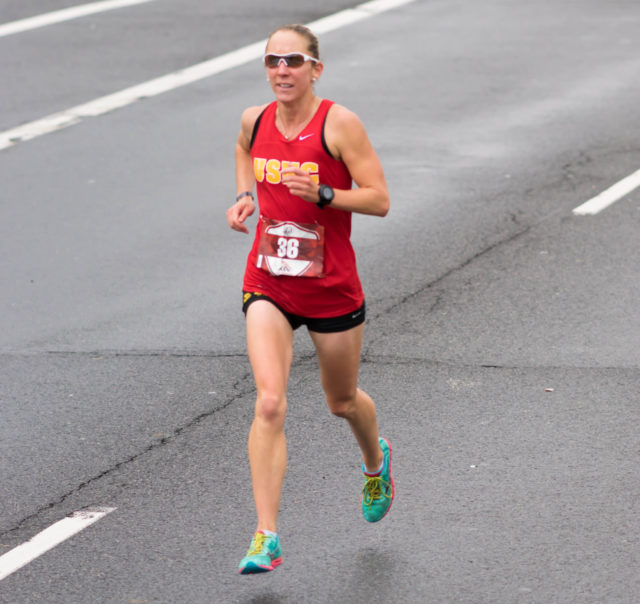
From her early days at the U.S. Naval Academy, Christine Taranto knew she wanted to be a Marine. Marines were tough and disciplined, the best of the best. The ones she met immediately impressed her. She worked to meet the Corps’ high standards for physical fitness and academic achievement. When she struggled, she doubled down to prove that she wouldn’t hesitate to put in the work. She remembers wanting the Marine evaluators to know, “Look, I’m not gonna give up. I want to do this… I’m not going to give up unless you tell me to.”
In its short life, the Woodrow Wilson Bridge Half-Marathon has been dealt some tough hands. In 2013, it was the first race put off by the government shutdown, though able to postpone by five weeks but seeing half of its registrants defer until the next year. Two years later, a hurricane forced a cancellation before missing the region entirely, an outcome that disappointed runners and organizers alike.
Race director Steve Nearman feels a little bit jinxed at this point. “I felt like a salmon going upstream ever since [2013], so it’s been tough,” he admitted after the race.
Wilson Bridge Half Marathon
Oct. 2, 2016, Alexandria, Va.
As this year’s event approached and another federal shutdown loomed, Nearman began activating Plan B, calling the many municipalities with jurisdiction over his course. Congress averted the shutdown late Wednesday night, but rain fell for the rest of the week. By Sunday, the fates relented, and on a cloudy and swampy morning, nearly 1,000 runners welcomed the race, the half and a 6k, back to Alexandria.
“I love it and I’m glad it’s back. I hope it’ll grow,” said Alex Hetherington of Vienna.
Ultrarunner, Sugar Shack owner, and former Virginia delegate Rob Krupicka is training for the JFK 50-Miler in November and has run this race each year. He too welcomed the race back to the city.
“I think it’s nice to have a race that connects Fairfax and Alexandria and gets you over the bridge a little bit too,” said Krupicka. “It’s nice and compact. It’s a really accessible race. Lots of people can do it.”
The race isn’t exactly as it was, as many returning runners noted. In prior years, prize money drew fast competitors, but Nearman couldn’t afford the purse this year. “I’m not saying that we have eliminated it for good,” he clarified, “but we just had to eliminate it this year for budgetary reasons.”
Hetherington noticed. He entered the race hoping to break 1:22, but he didn’t expect to place. “In fact, it was sort of a surprise result for me,” he said. “In the past, this race has had prize money, so it usually had a pretty fast field. So I didn’t know what was going on at the beginning of the race.” Hetherington eventually bested Matt Boyd of Fredericksburg to take third overall in 1:21:13.
The rest of the podium consisted of new faces. Colin McGrath dominated his debut race in the DC area, finishing in 1:13:30 with seven minutes on his closest competitor. McGrath moved from Philadelphia to D.C. with his girlfriend two months ago while he works on his dissertation.
While others found the course hillier than expected, McGrath called it cool and interesting. On the George Washington Parkway, he noted, “it’s either going up a little bit or going down a little bit but it sort of messes with your head because you can’t really tell what the grade is. It’s nice. At no one point can you totally check out because something’s happening.”
Behind him, Ron Gage of Houston came within a minute of his PR to finish in 1:20:32. A friend invited Gage to the race, and the trip appealed to Gage and his wife, who had not raced in the area before now. “It’s hot and humid down there, so this is a nice change,” Gage said of the slightly less hot but still very humid morning.
The women’s race, too, saw its pace slowed by humidity and changes to the field.
The Georgetown Running Club’s Kerry Allen echoed her victory on much of the same ground as the GW Parkway Classic, finishing in 1:25:16. She ran about half of the race with teammate and recent Clarendon Day 10k medaler Keely Eckberg (1:26:02).
“Then it got hard,” Eckberg said with a laugh.
Allen agreed, “Things sort of fell apart.”
Stephanie Cario (1:25:30), a former Virginia Tech cross-country runner and triathlete, crept between the two and managed to shave ten minutes from her finish time at the Parks Half Marathon last month.
“I thought it was going to be a lot flatter than it was,” she said. “And the humidity didn’t help.” She said she enjoyed the downhill portions of an up-and-down race and Allen and Eckberg agreed.
“Since we’re all training for marathons, I’m sure we’re all in the same boat, doing high mileage this week. Legs were feeling a little heavy, might be the consensus,” Allen said.
—
Nearman does get emotional about two aspects of his race. First, he wants to revive the Visually Impaired Championship that he built with Bethesda’s Joe Aukward (2:07:47), a two-time Paralympian who still holds four Indoor Track & Field records with the Association of Blind Athletes. Nearman is Aukward’s longtime guide in distance races, and Aukward ran the course today.
In the past, after the out-and-back along the George Washington Memorial Parkway, runners crossed the Wilson Bridge to a finish festival at the National Harbor, then rode shuttles back to the parking zones in Alexandria. Unable to secure event permits at National Harbor this year, organizers changed the bridge portion to an out-and-back and moved the finish festival to the base of the Wilson Bridge. Though logistically easier on the whole, the change narrowed the pathway along the bridge considerably.
“I wasn’t sure how that was going to work with the out-and-back on the bridge, running two abreast,” Nearman said. “It was more out of concern for their safety this year because we didn’t have the whole bridge.”
“Every year I always get feedback, ‘I was really hurting at 12 miles and I went behind these visually impaired people and I thought, wow, if they can do it, I shouldn’t be complaining!” he recalls. “They’re very motivating. They’re a really nice component of the race. We do hope to bring it back.”
Finally, this year the race also introduced the Nicole Mittendorff Memorial Award in honor of the Fairfax County firefighter whose disappearance and suicide in April garnered national attention. Mittendorff completed the race in 2013 and 2014, and when Nearman learned of the connection, he knew he wanted to do something. At the finish line, Nearman presented an engraved firefighter’s axe to Mittendorff’s husband, mother and father, who ran the race with their #MilesforNicole campaign for suicide awareness and prevention. “It was very emotional,” says Nearman.
Although the axe went to Mittendorff’s family today, Nearman plans to present it to the first female firefighter to finish future races.
“We want to keep her memory alive for as long as this race is alive,” he said.
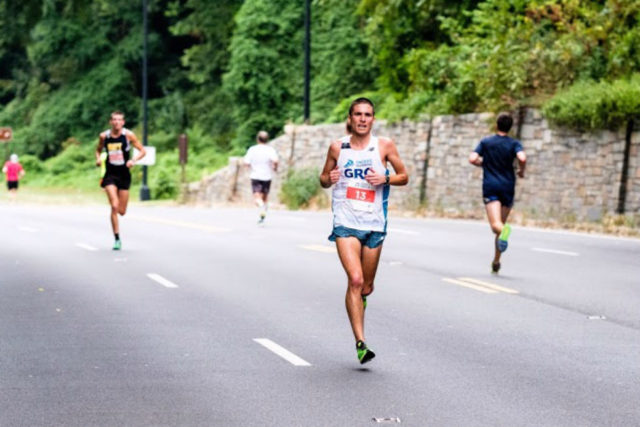
At the humid and overcast Navy – Air Force Half Marathon, many a runner had to temper their expectations. After a pleasant, mild Saturday, the return of sticky summer air on Sunday felt almost punitive. Yet the conditions did not stop Susanna Sullivan (Capital Area Runners) from crushing the women’s course record or Daniel Samet (Georgetown Running Club) from a speedy victory in his half-marathon debut. The Bethesda native ran for the Georgetown Day School and later, Davidson College.
Navy-Air Force Half Marathon
Sept. 18, 2016
“The weather conditions made it more challenging than I had originally anticipated when I signed up,” Sullivan said afterwards. “But I feel like I ran a smart race and I was happy with how it turned out.” For much of the race, Andie Cozzarelli of Raleigh, N.C. ran alone a few hundred feet ahead of Sullivan. Cozzarelli is a two-time All-American and alumna of NC State who now runs for Oiselle.
In an exciting late play, Sullivan made a move on Cozzarelli in the last half-mile, “which was a little later than I would have liked,” Sullivan said. “But coming out of Rock Creek on the downhill, I really feel like I picked up some momentum and rode that to the finish. I was relieved to pass her and I’m excited for the win.” She finished in 1:17:32, obliterating the 1:19:52 record set by Martha Nelson last year. In another universe, Cozzarelli’s (1:17:53) finish would also have broken the course record. In fact, the times of third-place Amy Laskowske (1:18:07) and age-group winners Perry Shoemaker (1:18:33) and Julia Roman-Duval (1:19:05) also topped Nelson’s 2015 record, an impressive showing considering the temperatures.
In the women’s masters race, Shoemaker bested Sullivan’s teammate Cristina Burbach, who has finished second in the category for several years. Burbach brushed off that history to give the race a go yet again. “This was a race that really rewarded patience,” she said. “You had to go out very conservatively and stay conservative far longer than you wanted to.” For her, this meant waiting until the turnaround in Rock Creek Park, nine miles into the race, to push.
She was surprised when she reached that point, that “really all I could do was hang on. But even as I was just hanging on, I found that other people were struggling, so the act of hanging on enabled me to pass quite a few people.” This humid half was Burbach’s last training race before the Chicago Marathon, which is also known for its unpredictable weather. She hopes that race will be more pleasant.
In the men’s race, Samet, Jordan Tropf (Navy), Blake Taneff (GRC), and Matt Deters (CAR) formed an early lead pack that strung out its chase pack by the time they left Hains Point, just 5 miles in. For his first half-marathon, Samet came out planning to run conservatively and executed that plan as intended. Like Sullivan would a few minutes behind him, Samet made his play in the ninth mile. After that push, he says, “I was lucky that I was able to hang on” to win in 1:10:37. Tropf followed him in 1:10:50 and Taneff took third in 1:11:17.
Runners at all levels powered through the soupy conditions anyway. Erik LeMoyne (1:33:05), a Marine, was recently stationed in Quantico and relocated to Virginia. He is training for his first marathon at Marine Corps and ran through calf cramps and a wall at mile nine today. “I set a lofty goal for three hours [at Marine Corps],” he says, “but I’ll probably have to adjust. Maybe like 3:10, but it’ll be my first one, so it’s a stepping stone to others.”
Despite struggling, LeMoyne enjoyed the race and its atmosphere. “I love the fact that, with everything that’s going on in the news and all of this negativity, that we can get some positivity around. Everybody’s coming out just to have a little bit of fun with each other.”
Some runners, like Reza Mohaddes (1:57:59) of D.C., still gutted out performances that made them proud. With his wife and sister watching, Mohaddes exceeded his own expectations for his first half. “My goal was like, just finish alive,” he says, “but I didn’t expect myself to finish alive, but I did.” Indeed, the bartender broke two hours and pushed through some tough final miles to earn his time. He’s excited at the finish festival, eyes lit up and talking fast. Asked if he’ll race another, he says, “Absolutely! I’ll race all the half-marathons and I’ll try to do the marathon as well.”
Traci Scott (2:01:18) and Artis Jones (2:03:38), members of the District Running Collective, didn’t feel phased by the morning’s weather, especially compared to the thunderstorms originally forecast. Artis laughs, saying that he’d been terrified of the storms but unhappy about the overcast morning. “I was like, I don’t want all clouds,” he said. “But then the sun came out. I was like, I need another cloud.” Although it only made a brief appearance, the sun was brutally hot in the moments it shone through.
Coming into the race, Artis had hoped to beat his time from last year, but “It was exactly the same!” he groans. (Online race results show that he finished 16 seconds faster this year, a technical victory to be sure.) Traci was aiming for two hours and fell just short. Both runners chalked up the successes they did have to the District Running Collective cheering squad, strategically placed at the Kennedy Center to greet runners in miles seven and 11.
“Our cheer squad is so lit. They’ll keep you going and motivated,” Traci says.
“They’re the only way I made it through,” agrees Artis.
Melissa Dentch (2:21:04) noticed the quieter atmosphere and the flashes of spectator support as well. “The runners were more supportive of each other than on a lot of other races I’ve done, which was really cool,” she said. “There wasn’t music or entertainment on the course so maybe everyone felt like they had to pull together a little more.”
Dentch trains with Team RWB. Military races like this one mean more to her now that she has friends who currently or previously served. “A lot of them are running for people that they’ve lost and people that they know and people who couldn’t be here today for whatever reason,” she says. “So it’s really powerful and meaningful to run with them, run alongside them, and support them.” Her teammate, Jennifer Janowski, joined a few other Team RWB members and the November Project to cheer runners through the finish line.
“It’s not like some of the bigger races,” Janowski says. “You actually get to see people cross the finish line.” She’s one of several people who praises the size of this race; with about 9,500 finishers in the half-marathon, it’s a third of the size of the Army 10-Miler or Marine Corps Marathon. Because she is tapering for Ironman Louisville, for this race, Janowski was happy to bring flags, energy, and Eagle fire to the end of the course.
Ultimately, regardless of the conditions, half-marathons can be a tough race. Nearly everyone interviewed felt some pain in the final miles of the race. Samet’s advice? “It’s a grind, so you just gotta be gritty and go after it.”
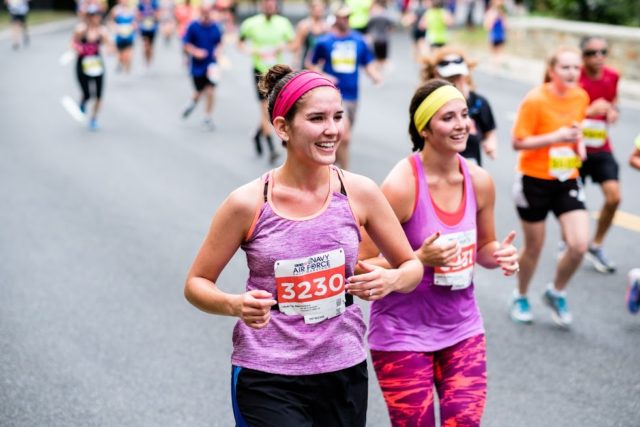
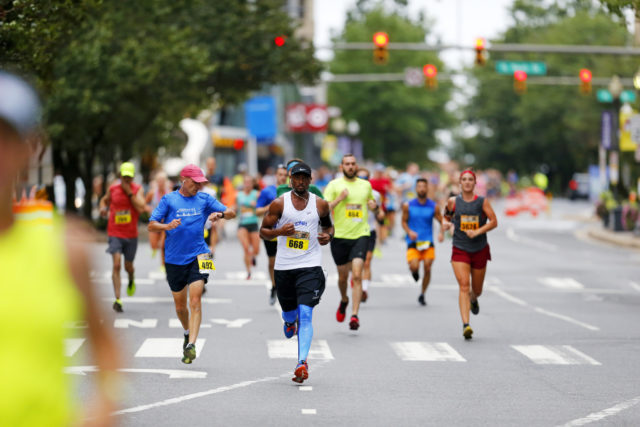
With fall racing season upon us, runners of all ages and abilities converged on the 2016 Clarendon Day races. The 5k/10k/double race fell a week earlier than usual, and though September weather can be unpredictable, the morning dawned mild and slightly overcast. Undeterred by Safetrack delays, 1,145 runners gathered atop Wilson Boulevard to start the 5k. After the races, daylong festival
Clarendon Day 5k/10k
Sept. 17, 2016
The course was quiet except for the pounding of shoes and panting of the fastest runners. Dashing towards Rosslyn, Clint McKelvy (14:36) of Arlington took an early lead that became insurmountable by the end of the second mile. At the finish line, McKelvy and his cheering squad debated his finish time, which fell just two seconds short of the course record.
“I thought I could have [the record] with a really good day,” McKelvy said. “I did not expect to get it when I was running solo for the last mile or so. It definitely helped having Stewart [Reich], the guy in second, pushing me the first two miles.”
Behind him, Reich (14:45) of Frederick and Tripp Southerland (15:11) of D.C. rounded out the top male finishers in the 5k. In the women’s race, Maura Carroll (17:35) of Arlington took first, followed closely by Jennifer Brill (17:51) of Arlington and Elyssa Gensib (17:54) of Alexandria.
Runners throughout the pack had strong performances and positive outlooks after the race. Waiting for her friend Tina to finish, Vinita Ollapally (28:32) mused about finish times. “I used to run a lot faster,” she said. “I’m not used to seeing 28 minutes on the clock. But I think it’s just, you know, you’re a runner no matter what. So even if you run slowly you’re not any less of a runner than the runners who are running really quickly.” She and Tina chose the race to set fitness goals for themselves.
Elizabeth Bolton (38:24) of Alexandria (who is this writer’s sister) smiled at the finish line and announced, “I just ran a personal worst!” with equal enthusiasm. She wasn’t disappointed, as she hasn’t been training and is now in the third trimester of her first pregnancy.
Another runner, Lizzie Gomes (38:59), chose the race for her first 5k at a friend’s suggestion. “I thought I was going to struggle and probably be last but I wasn’t!” she said quietly. That friend’s boyfriend, who declined to be interviewed, couldn’t help but chime in, “She’s a superstar today.” Although Gomes plans to stick to 5ks for the near future, she liked the course and felt positive about running the race again.
Shortly thereafter, 910 runners began the 10k. Many of them had trudged back uphill from the 5k finish–some 250 runners doubled up this morning. As in the 5k, a small lead pack broke away on the downhill, but even with the longer flat around the Pentagon, the winner proved unstoppable. Desta Beriso Morkham crossed the finish in 30:50, so nonplussed that he looked around and asked, “Finished?”
Morkam, who is Ethiopian, won his first American race by 40 seconds. “It’s good, it’s good” he said, grinning. “I am very happy because of this good weather for me.”
Behind him, Stewart Reich (31:40) and Matthew Barresi (31:52) took second and third, making Reich the overall top finisher in the double. Still panting, Reich said, “It went well. It was fun. I’ve never done anything like that.” Like Morkam, Reich and Barresi appreciated the conditions and shrugged off the morning humidity.
“The wind was in your face for a bit, but it’s September in DC so that’s what you get,” Barresi said. He added, “If the sun was out, it would have been baking us.”
In the women’s 10k, GRC runner and recent Northwestern grad Elena Barham dominated her first road race. Her 36:16 finish placed her ninth overall and was fully two minutes faster than the next woman, her teammate, Keely Eckberg (38:17). Barham’s strategy was to “just get out there and compete,” which she certainly did.
“There were some great men right around me and they were very, very helpful… [They were] just running really steady so I could kind of like, tuck in. Profit off their hard work a little bit,” Barham said.
Behind her, Eckberg seemed flustered by her finish. “I’m training for a marathon so [my strategy was] just hold a steady tempo pace, I guess. I’ve been feeling good in my workouts, so I dunno. Just to go out and run it,” she said, still trying to catch her breath.
She added, “I live right around here so it was motivating to see my apartment on the way back.”
Just past the finish line, third-place woman Barb Fallon Wallace (38:25) joined fifth-place Amy Nichols (39:56) to stretch and discuss returning to running after pregnancy. Wallace recently had her third child, and Nichols is newly returned to running after her first.
“[Barb] said just try not to set expectations and your body will get back into shape when it wants to,” Nichols said. “Of course I had impractical expectations but I was pretty happy with it, although I finished extremely out of breath. I thought I was going to die.”
For her part, Wallace simply wanted to run a controlled race. The first downhill mile challenged her, but she humbly accepted her finish, saying, “I figured if I didn’t catch [the leaders] then I wasn’t gonna be fast enough to run with them.”
Reich, Wallace, Nichols, and many other doublers used the race as a tune-up, particularly for the upcoming Army 10-Miler. Many set PRs thanks to the speedy first mile. Some, like Madeline Shepherd (22:03/49:44) and Justin Hewitt (17:55/38:55), thought they had taken down two personal bests. “This was my first time running any of the Clarendon Day races and it definitely is exactly as described — super downhill, really flat, really easy PR. Lot of fun,” said Shepherd, who also enjoyed the bananas.
“Couldn’t have asked for a better day,” Hewitt agreed. “Overcast, cool conditions, really well-organized like [Shepherd] said.” He is training for Marine Corps after a friend unexpectedly transferred a bib to him. Shepherd is training for the Army Ten-Miler after appendicitis knocked her out of last year’s race. Both felt good about their fall season after today’s shakeouts.
An outsider would be forgiven their confusion at the sight of so many grimacing runners grunting, “I’m happy,” at the finish line. We don’t usually associate this much wincing or sweating with easygoing happiness. But with the pleasant conditions, PRs dropping like dominoes, and legs tested for upcoming goal races, these runners earned their good vibes.
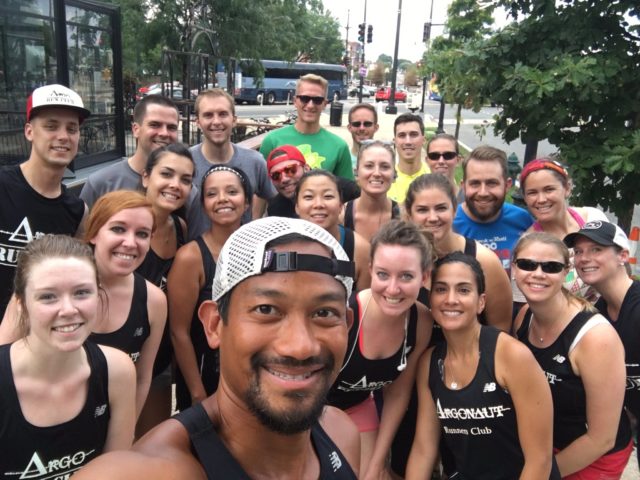
The Argonaut has been closed since mid-July, but the club has been meeting at Liberty Tree, at 1016 H Street NE, in the meantime. Find out more on the club’s Twitter page.
On a cool, overcast Friday evening, the Argonaut Running Club gathers outside the new patio bar of its namesake and sponsor. The club is a week past its six-month anniversary, and the weather has finally cooled, so the group is a little bigger than in summer. Several runners wear their Argonaut Running Club shirts, awarded after five runs with the group, and more ask about the trucker hats that are about to become available.
Organizer Ariel Laguilles welcomes runners one by one, by name, asking about training or injuries and marking their attendance. “That’s the teacher in me,” he says, paging through his packet to a waiver that he asks me to sign. Runners introduce themselves to me, too: Leah, who has only run with the group once before; Marissa, Laguilles’s wife; Stephen, a colleague of Laguilles’s. Have I run with the group before, they ask. Do I live in the neighborhood?
Most of them do. The club draws runners from the H Street Corridor, where a few chain sporting goods stores carry the basics, but specialty running stores and their corresponding running clubs are a few miles away. Even social clubs are limited: the H Street Runners, formed in 2012, meet a little more than once a month. More than a few top search results for “running” and “H Street NE” mention the one thing in the neighborhood that doesn’t run: the streetcar. (Editor’s note: this story was published in late 2015)
The club was born on a snow day last February when Laguilles overheard the owners and managers discussing activities for the upcoming season. “I was just
eavesdropping,” he admits. “I mean, I was alone.” But when co-owner Shaaron Pine asked his opinion, he floated the running club he’d been missing. The restaurant had become an institution in the neighborhood, rallying the community after a devastating fire five years ago. “It was a no-brainer having a brick-and-mortar spot to meet every week, a consistent time,” Laguilles says. “Every Friday at 6, everyone knows that we’re going to come and run, whether it’s two or three of us to 15, 16 of us, there’ll always be people to run with and then hang out, socialize with.” With some social media and signage around the bar, the club was born.
Stephen Szolosi has lived nearby for five years and works with Laguilles at Gonzaga High School. He originally joined the club to support his friend but he stayed for the sense of community it built. The club, he says, is made up of “people who are part of that [H Street] community and want to get to know others and end up getting to know people who live a few blocks away and then enjoy the running on top of that and the happy hour to boot.” Leah Loloyan reiterates this, saying, “Especially since a lot of the people are from this neighborhood, I feel like I’ll see them randomly running.”
It’s Friday evening after a challenging week. Working at a Catholic high school means Laguilles, Szolosi, plus Catholic University students Matt Gatti and Emily Thompson, have been caught up in the visit of Pope Francis. With the dozen others gathered, the group collectively eschews its four and six-mile routes for an easy two around the neighborhood.
Pine snaps a group photo before we take off down Maryland Avenue. We settle into loose pace groups. The route itself is very nice: flat, mostly on brick sidewalks, stopped by few stoplights, and greeted by neighbors as we pass. “Whoa, Argonaut has a running group?” marvels a man walking his bicycle down G Street.
Over and over again, the Argonaut runners talk about the welcoming atmosphere and sense of community the group has developed. Loloyan is here for the second time ever, impeded by a travel-heavy work schedule. “I did come back,” she exclaims. “And I will continue to come back whenever I can because everyone’s so friendly and you meet new people.” Her boyfriend has joined her at the bar and he jokes, “She’s here because I don’t run.”
Sara Betancurt agrees, commending Laguilles and his wife, Marissa McInnes: “They always remember you, they always say hi, they always ask about your day. They don’t forget you, even if you’re gone for three or four months.” She was part of a group from the club that ran the Capitol Hill Classic in May, where they debuted their team shirts, and she recently returned to the club after being injured.
First timers Gatti and Thompson caught the group a few blocks into the run, having started their day running with the nonprofit Back on My Feet and coming straight from delivering meals to the homeless in McPherson Square. Gatti is a former student and current co-coach with Laguilles who had been meaning to come down from Brookland for a while. Finally having seen it for himself, he smiles as he says, “It’s a great experience, great people, great running, great happy hour, good beer.”
“After the craziness of this week, I feel like a nice easy two mile run and a drink after was just right,” agrees Thompson. “Definitely necessary to unwind.”
Upstairs at the Argonaut, Laguilles lights up to talk about the future of running in the neighborhood. “One of our goals also is to work on that and bring people out here to Northeast and bring the running community from other parts of D.C., Maryland, Virginia to H Street,” he says. “We just had a big festival [the annual H Street Festival]. It’s a hot spot and people know it but I think it’s time for the running community to lay a stake here in this area.”
He dreams of a 5k or even a mile race in the neighborhood, maybe taking advantage of the nearby National Arboretum or Anacostia Riverwalk trail. “There’s tons of untapped potential in terms of running in this area,” he says.
“It’d be great to share that with everyone and people from other parts of D.C., bring them over here.”
The Argonaut Running Club meets Friday evenings at 6 p.m.
This originally appeared in the Winter 2015 issue of RunWashington.
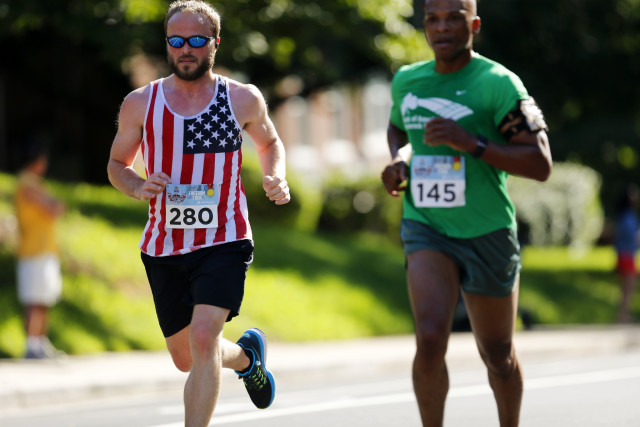
When it comes to the Freedom Four, there’s only one rule: you must respect the hill. You have two miles to contemplate it on the way down, and a moment of reckoning when you turn back to face it. Did you burn yourself out on the downhill? Were you so cautious that you can’t make up the difference in the climb? The hill can make or break a race.
Now in its second year, the Freedom Four takes the out-and-back, down-and-up course of the Four Courts Four Miler and drops it in the middle of summer. Now they’ve combined a demanding course with unpredictable weather. The race could be unforgiving–this year, the weeks preceding it were unusually hot for June, and severe storms pummeled the region through Saturday. Fortunately, race day dawned clear and mild, with temperatures about 10 degrees cooler than they had been. A breeze blew often enough to be welcome as it provided relief from the baking sun.
Just before 8 a.m., runners gathered at the top of Wilson Boulevard and Courthouse Road, where they peered down the vertiginous drop before them. When the gun went off, they came down like an avalanche, resting their legs on the two-mile flat before an unforgiving climb back to the finish. The men’s race was tight to the end, with Julian Meyer, 24, of Peninsula, Ohio, edging out locals Matt Rand, 23, of Alexandria and Mynor Lopez, 31, of Falls Church. All three finished within the 20th minute of the race, and Meyer came within 5 seconds of the course record set last year.
The first woman to finish, Alexandria’s Emily Potter, 36, seemed almost in disbelief at her victory, despite finishing in 23:53, a comfortable near-minute ahead of her next competitor, Megan Haberle, 35, of DC. “I just got back from a week at the beach last night” she says. Like many others, she gives thanks that the weather took an agreeable turn. But she’s no stranger to hills, and it becomes apparent why her performance was so strong: “I like hills,” she says with a laugh. “I train pushing my double running stroller most of the time, so it felt pretty good to be able to run a hill by myself.” Rachel Clattenburg, 31, of DC rounded out the top women’s finishers.
In the crowd, runners remained spirited. They gritted their teeth til the finish line, streaming sweat and often looking a little nauseous as they crossed. But by the time they had water and a banana in hand, everyone was smiling again. Many were experienced runners drawn to the unique distance, challenging course, and festive atmosphere. Dani Lager, 28, of Silver Spring, and Hanna Pillion, 26, of DC were two of just a few costumed runners on the course. While most runners opted for red, white, or blue shorts, Lager sported a tank top and shorts covered in American flags and Pillion a Wonder Woman costume. “It’s not breathable, no,” said Pillion, tugging the synthetic fabric. “It was kind of hot, actually. But running as Wonder Woman, you get a lot of extra people cheering for you, so that helps you run faster.” Lager seconds the motivational effects of crowd support, then flips it: “Hopefully, we’re inspiring others. People see us and they’re like, ‘Yeah, I’m gonna keep going!'” Both are training for longer distances in the Fall and were excited to “celebrate America” at the Freedom Four.
10-year-old Madelyn Stokes runs with her father, Marc Stokes, 43, to stay fit for soccer. She finished the race in 32:30, winning the group for girls under 14. Asked how the course was, Maddie stuck out her tongue and panted “Hard!” The Fairfax native had her own approach to conquering the hill that humbled many older runners: “I was looking down the entire way, so I didn’t really know what was going on,” she admitted.
At the other end of the age groups, John Finney Jr. raised a beer to the cheering crowd as he accepted his own award. The unstoppable 75-year-old runs almost 30 races per year and is training to complete his 26th marathon this fall. He’s overjoyed to be part of the running community and an avowed fan of Pacers events like the Freedom Four. “It was a terrific race, well managed, well organized, good water stop,” he said. “It got a little bit hot towards the end, and the two hills are character-building.” With such a positive attitude, it’s no wonder he’s still running as much and as fast as he does. He finished in 42:43.
Finney gushes about running, “It’s a privilege to be out there. It’s wonderful to feel the energy and the excitement of the younger runners, and then when I see the older runners like myself, it’s wonderful to be out there with them striving and working and doing the best we can to keep up with the younger generation. […] It really is a blessing and it keeps us young and it keeps us agile and it’s really exciting to be a part of these Pacers runs and I’m a huge fan of your magazine.” Then Finney introduces his friend Shaun Mistlebauer, 57, of Arlington. “He’s going to help me train for a triathlon in August!” Finney grinned.
“We love to run. We wanted to try something new,” said Giovanni Harrison, 34, of Clinton, MD. He and Nelson Flores, 28, of Hyattsville ran the race as part of a three-race package they purchased. Both were worn out from the hill but nonetheless spoke excitedly about their upcoming summer races, including the Crystal City Twilighter. Flores laughed, “Hopefully there’s no more hills like this!”
In all, over 700 runners from across the region faced the hill with some balance of caution and confidence and came away eager to continue their running seasons. “I will never look at that road the same,” Flores said. “I have a whole new respect for Wilson Boulevard.”
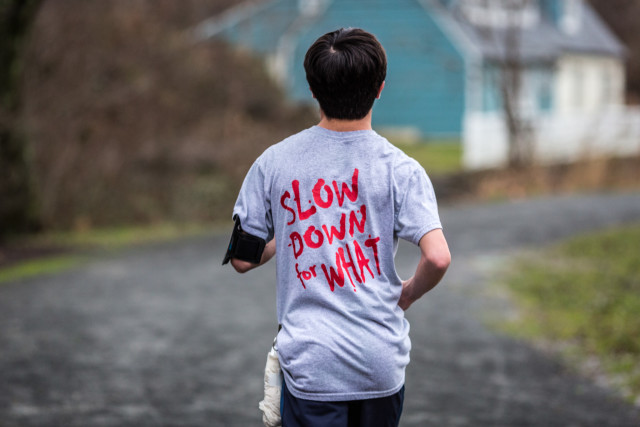
Matthew Hua relished his first season of cross country at J.E.B. Stuart High School. With no prior athletic background, his 24-minute three mile time is a point of pride. Lifelong health problems have been an obstacle in his running career, but they haven’t stopped him from fully participating as part of the team — except maybe in the team dinners.
Matthew’s gastrointestinal system has never functioned normally. He is unable to eat at all and drinks very little. In fact, virtually every one of his bodily systems is compromised. He is deaf in his left ear and his left vocal cord is paralyzed. Underdeveloped lungs have led to chronic conditions such as tracheomalacia (softened cartilage around the trachea) and asthma. He has ongoing orthopedic problems and his immune system is compromised, leaving him susceptible to infection and illness.
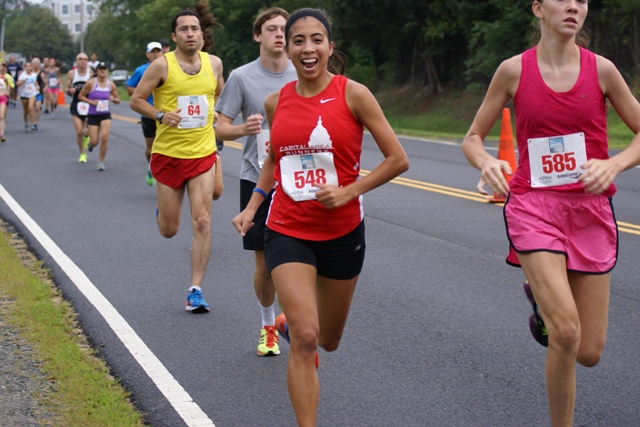
It was time, and Kelly Swain knew it.
“I was always working up to a marathon,” she said just a month before toeing the line at the Marine Corps Marathon.
The 29-year-old Burke native has been running since high school, but wanted to wait for the right moment to commit to 26.2 miles. She started running while at Lake Braddock, encouraged by her older sister’s achievements, but quickly became successful in her own right. That sister, accomplished local runner Erin Taylor, recalls “some middle school race, or high school, [Kelly] either won the mile or got second. I was like, ‘People think I’m fast? She’s gonna be way faster.”
Swain went on to run at the University of Virginia, but injuries and the pressures of collegiate running kept her from the “normal college experience” she wanted, the kind where your peers aren’t working like professional runners to maintain their scholarships. She declared herself retired.
“I just needed a break and didn’t think I really liked running any more,” she said.
She’s not alone.
“A lot of these runners come out of college programs burnt out,” said George Buckheit, Swain’s coach with Capital Area Runners. “They just feel like running isn’t fun, and I think one of the strengths of what we put together at Capital Area Runners is we’ve got a group that is very supportive.” This has been a selling point for Swain’s return; both sisters praise Buckheit and their teammates for the motivational atmosphere that sets them up for their success.
“The Ultimate Progression”
“When I came back to running three years ago, I promised myself I would not let it consume my entire life,” Swain said.
Instead of cutthroat competition, she made the choice to set time goals and encourage runners who might pass her.
“I think when I took the focus off of competing with other runners and placed it on my own ability, I started loving running once again,” she said.
Still, to her, the marathon was “the ultimate progression” in a runner’s career and her unspoken goal was to finish her first in under three hours. To get there, she spent two years rebuilding her base with CAR and the last year racing the Army Ten-Miler, the Richmond Half Marathon, and most recently, the Navy-Air Force Half Marathon. Her times show little hint of having recently come out of retirement. In fact, she won the Marine Corps 17.75k in March and placed fifth at the Navy-Air Force Half-Marathon. But she had to rebuild her confidence alongside her mileage before she considered going farther.
“I didn’t want to just do a marathon to do it,” she said. “I wanted to do a marathon to know that I was going to run well and that I was well prepared.” Doing well, for her, meant being thoroughly prepared to break three hours. “I guess this is the year that I thought I was ready to do that,” she said, with characteristic humility. Because runners love a challenge, she also scheduled her wedding to to fiancee, Brendan Mahoney, for Nov. 1, 2014, just six days after her marathon.
With any luck, the post-race soreness will wear off before it’s time to dance.
“I never make any bold predictions on a race, especially a marathon,” Buckheit said of her upcoming race. “It’s so unpredictable. But she’s running great. This is as well as she’s been running since she’s been with us.”
Swain is also running her highest mileage ever, and without injury, which Buckheit attributes to better recovery practices.
“She’s ready,” Taylor said. “She knows how hard a first marathon can be, especially if you go out too fast like I tend to do and then you’re pretty much crawling in. She’ll run better than I did my first.”
Taylor’s pride in her sister shines through every praising word she said. “That week is going to be amazing for her,” she gushed.
Race Day
On marathon morning, Swain plans to heed the advice of her coach to start slow and finish fast. She attributes her success at the Navy-Air Force race to staying slow through the first 5k, per Buckheit’s advice. “I never believed him at first until I actually started to do it in races,” she said.
Buckheit and Taylor shared their advice for Swain, the thing they’d like to repeat in her ear for 26.2 miles.
Taylor said to have fun. “At the end of the day, there’s gonna be some part of the race I would think [will] hurt worse than anything that’s ever hurt before, and just to remember you’re doing this because it’s fun.”
And Buckheit reiterated the need to be patient. In the first 10k, he said, “If you don’t feel like you’re running too slow, you’re running too fast. […] Wait until everyone else has made their early race mistakes and starts crashing, and that’s when you pick your spot to start moving your way through the field.”
Most of all, they share the unequivocal opinion that she is ready. She has trained hard and run well throughout her training. All that remains is to race.
“We’re rooting for her,” her sister said.
This article originally appeared in the November/December 2014 RunWashington.

In 2013, runners from the D.C. region traveled more than 37,000 miles to finish marathons as near as Baltimore and as far as Honolulu, and that’s before we count trips to marathons on other continents. This region may play host to the venerable Marine Corps Marathon and the fresh-faced Rock ‘n’ Roll USA Marathon among more than a dozen others, but it’s safe to say that runners here have shoes, will travel.
What’s not to love about a destination race? You can choose a course that plays to your strengths, take a 26.2-mile tour of another city, or visit friends and family. Sure, you might struggle with jet lag, toss and turn all night in an unfamiliar bed, or realize that you left one of your shoes back in Bethesda. But you’re also about to share an experience with hundreds or thousands of fellow marathoners who know all the highs and lows of a training cycle and who want you to succeed only slightly less than they want to beat you across the finish line.
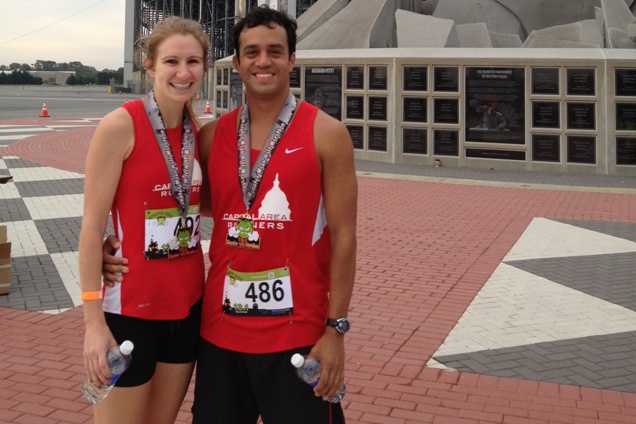 Twenty-two miles into the 2013 Richmond Marathon, Juan Sanchez passed Lauren Shaub. Shaub, an assistant coach with the Capital Area Runners, was long resigned to not breaking three hours; at mile 16, she remembers CAR head coach George Buckheit telling her, “Just hang in there!”
Twenty-two miles into the 2013 Richmond Marathon, Juan Sanchez passed Lauren Shaub. Shaub, an assistant coach with the Capital Area Runners, was long resigned to not breaking three hours; at mile 16, she remembers CAR head coach George Buckheit telling her, “Just hang in there!”
Meanwhile, CAR member Sanchez was running his third marathon after being inspired by Boston. He had started the race slow and reached a pace well above his standing PR. As he fell in alongside Shaub, Sanchez sensed that he would have to push his coach and training partner through to the end of the race. Acutely aware of Sanchez’s pace and peppiness, Shaub gave him one order: “Just go.”
That’s love.
Some might find it hard to live, train, and plan a wedding with another runner, but Shaub, 31, and Sanchez, 32, have found that a supportive partner makes all the difference. She is a longtime competitive runner who thrives on training, planning, and analyzing. He is a former wrestler who relishes racing but admits he isn’t ‘running for the sake of running’ just yet. She runs early, before spending all day on her feet as a physical therapist. He prefers to run in the afternoon. She’s trained with teams since high school; he first tried speedwork when he joined CAR this year.
Shaub and Sanchez met, of all places, in an operatory. Shaub was in a new job and observing a shoulder surgery; Sanchez was an injured wrestler mostly hidden behind a curtain.
“I honestly don’t remember meeting her,” Sanchez recalls. Shaub adds, “In a shoulder surgery, all you see is the person’s arm, so I didn’t really see him much.” When he returned to the office for physical therapy, Shaub asked how his shoulder felt. They began chatting during his sessions and their casual friendship expanded to the gym where they both belonged. “He and his friend asked if I wanted to lift with them,” Shaub remembers.
“He’s very romantic.”
“Are you sure?” asks Sanchez, unbelieving. Shaub reciprocated by inviting him to a spin class.
Before his 30th birthday in 2010, Sanchez began training for the Marine Corps Marathon, which is how he found out that Shaub too had been a college athlete. They ran together occasionally until Shaub invited Sanchez to happy hour. “I didn’t know the rules of engagement, to say the least. I was still going to therapy at her clinic,” he remembers.
“It wasn’t a date,” Shaub clarifies. “I thought, ‘Oh, this guy is the only young guy that comes in here; he’s the only young guy that’s single and cute. He probably has cute friends. I’m gonna ask him if he and his friends wanna meet me and my friends at Whitlow’s.”
Sanchez came alone.
Nonetheless, the two became closer. Their joint training, plus Sanchez’s long runs with Potomac Runners, paid off with a 3:27 finish at Marine Corps.
Friendship elided into a relationship. She liked his athletic and military background, which paralleled her own regimented training.
“I know what he went through; he knows what I went through,” Shaub says of college athletics.
As the student athletic trainer for her high school wrestling team, she knew his sport well. And the better she got to know them, the more she liked his friends. “That told me the person he was, that he kept putting fabulous people around him,” she says.
For his part, Sanchez recalls inviting Shaub to watch a wrestling meet. She agreed, “no hesitation. That was like the turning point,” Sanchez recalls: “She was hot and she liked to go to wrestling tournaments.”
“And I’m still hot and I still go to wrestling tournaments,” Shaub interjects.
They continued to train and race together throughout their relationship, getting engaged in March of 2013. In the same year, Coach Buckheit made Shaub his assistant coach and welcomed Sanchez onto the team. Shaub’s physical therapy background had helped her teammates greatly.
“For quite a while, I’d been leaning on her to assist in those rare occasions when I broke somebody,” Buckheit remembers. He had taken on work with charity runners and Shaub could help instill good strengthening and stretching habits in the beginners.
Meanwhile, he watched Sanchez take to training like a fish to water. “I think this is just the first time [since college] that he had been diligent about getting on a training program and sticking with it,” says Buckheit. He often sees former athletes return to form in the warm embrace of a supportive team and a disciplined training plan. “If you know you’ve gotta meet somebody for workouts several days a week and one of them’s your [fiancee], it keeps your feet to the fire.”
As Sanchez made huge beginner’s leaps, Shaub nudged minutes off her own times. Racing together, they occasionally managed “Hollywood finishes.” At the 2013 Monster Mash Half Marathon in Dover, Shaub’s regular training partner Kelsey Budd took second overall and finished as the first woman. Shaub followed in fourth overall, the second woman. Just 31 seconds behind her, almost before Shaub knew what was happening, Sanchez crossed the finish line, placing third in the men’s race.
“I ran a PR,” Sanchez says humbly. “It was a 10-minute PR,” Shaub adds. Suddenly, a BQ seemed possible for Sanchez.
Is it all sunshine and roses to date another runner? Not entirely, they concede; someone has to walk their dog Rook, Sanchez’s American Staffordshire Terrier and their number one fan. Their training schedules don’t always leave them much time to relax together. After workouts, they sometimes fight over the bathroom.
But the good outweighs the bad. They have a built-in training partner to motivate them or at least wake them up in the morning. They understand one another’s goals and intentions, and they support each other when training is difficult. Now that Sanchez is training, he tires out earlier and spends fewer late nights out. “I’ve adjusted my lifestyle. It’s good for me,” he says, and early-rising Shaub agrees.
Despite their individual commitments to running, the couple won’t be getting married mid-marathon or racing to the courthouse. Shaub promises to run that day, saying, “If I have to get up at 2 a.m. to do it, I will. Running, for me, is a stress reliever.”
Sanchez hesitates. “I can’t say I’m going to [run],” he admits.
Still, no runner of their caliber could plan a spring event without taking the sport into consideration. “A lot of my friends are runners, and I didn’t want to interfere with Shamrock, Cherry Blossom, Boston…. I’ve already talked to our caterer about making sure that certain people are refreshed with more water than other tables,” Shaub says. They plan to honeymoon in Brazil for the World Cup.
When their paces converged on that fall day, Shaub remembers thinking, “He needs to qualify for Boston!” before urging him on. He’d hated spectating the year before, finding he really wanted to run what he saw as “the Big Daddy” of marathons. When Buckheit saw Sanchez crest the race’s final hill first, he quipped, “Oh boy, the wedding’s off.” Still, he’s confident that with patience and hard work, they will both break three hours soon. “They’re knocking on the door right now,” he says.
In the end, Sanchez ran a Boston-worthy 3:03:38 in Richmond and Shaub set her own new PR of 3:06:24. Despite their coach’s concern, the wedding is still on. In the finisher’s chute, Sanchez hung Shaub’s medal around her neck. As on running and wrestling teams, their individual achievements make their partnership stronger.

